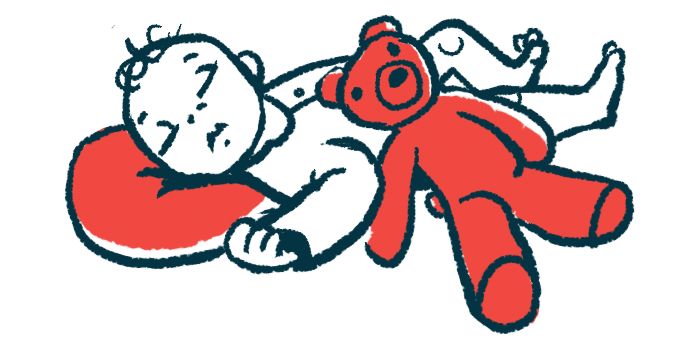Using Copaxone while breastfeeding safe for infants: Study
Babies did not have more adverse events, hospitalizations, or need more antibiotics

Infants breastfed by mothers on Copaxone (glatiramer acetate) for relapsing forms of multiple sclerosis (MS) do not experience more adverse events, hospitalizations, or need more antibiotics for the first 1.5 years than those in the general infant population.
That conclusion comes from new analyses of data from COBRA, a real-world safety study in Germany assessing Copaxone’s effects on breastfed offspring.
The findings add to previous COBRA data suggesting that Copaxone’s benefits for the mother during breastfeeding “outweighs the potential, apparently low risk of untoward events, in their breastfed offspring,” the researchers wrote.
The new data were described in the study “Safety evaluations of offspring breastfed by mothers receiving glatiramer acetate for relapsing multiple sclerosis,” published in the journal Multiple Sclerosis and Related Disorders.
Most people with MS have relapsing forms of the disease where existing symptoms may worsen or new ones may appear during a relapse, usually followed by a period of remission when symptoms improve or go away.
The disease is more common in women than men, and when women give birth their chances of experiencing a relapse are higher. However, there are only a few disease-modifying therapies (DMTs) for MS that are considered safe to use while breastfeeding.
One such medication is Teva Pharmaceuticals’ Copaxone, whose label in Europe was updated last year to remove a warning against its use during breastfeeding.
In the U.S., Copaxone’s label states that the therapy has not been studied rigorously during pregnancy or while breastfeeding, and that women planning on becoming pregnant or breastfeeding should discuss the therapy’s benefit-risk ratio with their healthcare team.
The update on Copaxone’s European label was supported by data from COBRA, which analyzed 1.5-year safety outcomes of 60 infants whose mothers were receiving Copaxone while breastfeeding versus 60 infants whose mothers were not on any DMT during breastfeeding (control group).
All data came from the German MS and Pregnancy Registry in the years 2011-2020.
Previously published results showed that the infants’ developmental and growth parameters, hospitalizations, and antibiotic use were similar between the two groups, supporting the safe use of Copaxone during breastfeeding.
Taking a longer look at Copaxone and breastfeeding
Now, researchers extended the analyses by looking at the type and frequency of adverse events, or side effects, in breastfed infants, how long they were exposed to the medication, how many times they were admitted to the hospital or took antibiotics and why.
The median length of breastfeeding was about the same in the Copaxone and control groups (7.9 vs. 8.1 months). Infants were exposed to Copaxone for a median of seven months during breastfeeding, with five of them having been exposed for less than one month.
The number of side effects was comparable between the two groups (82 vs. 83), as was the number of non-serious side effects (59 vs. 61) and serious side effects (23 vs. 22). In both groups, side effects “were diverse with no specific patterns, and [adverse event] types were similar between [groups],” the researchers wrote.
The duration of Copaxone exposure among infants experiencing side effects ranged from six days to more than 1.5 years.
Some exposed during pregnancy
Most infants (86.7%) in the Copaxone group also were exposed to the therapy during pregnancy. One-quarter of infants in the control group were born to mothers who had stopped taking Copaxone in the first trimester of pregnancy, as per the study protocol.
The median length of Copaxone exposure during pregnancy was twice as long for infants exposed to the therapy during breastfeeding than for those who weren’t (66 vs. 29 days).
There was a similar rate of hospitalization between the groups, with 12 reported hospitalizations in 11 (18.3%) of the Copaxone group infants and 16 hospitalizations in 12 (20%) of those in the control group.
The frequency of all-cause hospitalizations in the Copaxone group also was comparable “with the general infant population at the age of up to 12 months in North Rhine (Westphalia, Germany), where 18.7% of boys and 14.9% of girls were hospitalized for any reason at least once in the first year of life,” the researchers wrote.
Reasons for hospitalization “were diverse with no particular pattern,” the team wrote.
Infections most common reasons for hospitalization
However, the most common reason was infection, which was more frequent in the Copaxone group (41.7% vs. 25%). Only two of these occurred during exposure to Copaxone while breastfeeding.
Median Copaxone exposure duration was comparable between infants hospitalized due to infection and those hospitalized for other reasons (137 vs. 110 days), suggesting “there is no dose-dependent harmful effect,” the team wrote. Median exposure to Copaxone during pregnancy also was similar between these two groups (median 49 vs. 30 days).
Nine infants (15%) in each group used antibiotics, but more frequently in the Copaxone group (13 vs. 10 times). This likely was due to the fact that one infant in the Copaxone group needed antibiotics four times to treat infection due to a kidney malformation that occurs in about 1% of the general infant population.
Excluding these urinary tract infections, there was no specific pattern of antibiotic-treated infections across the groups.
“Duration of [Copaxone-exposed] breastfeeding at the start of antibiotic treatment was variable and similar to breastfeeding by the control [group], thereby revealing no pattern of potentially harmful immunosuppressive effects,” the team wrote.
“Overall, COBRA data have confirmed a lack of adverse safety outcomes in offspring of [Copaxone-treated] mothers, followed-up for 18 months, … versus control offspring or the general population,” the researchers wrote.
“These data add to the growing clinical evidence supporting [Copaxone] use during breastfeeding,” they concluded.







